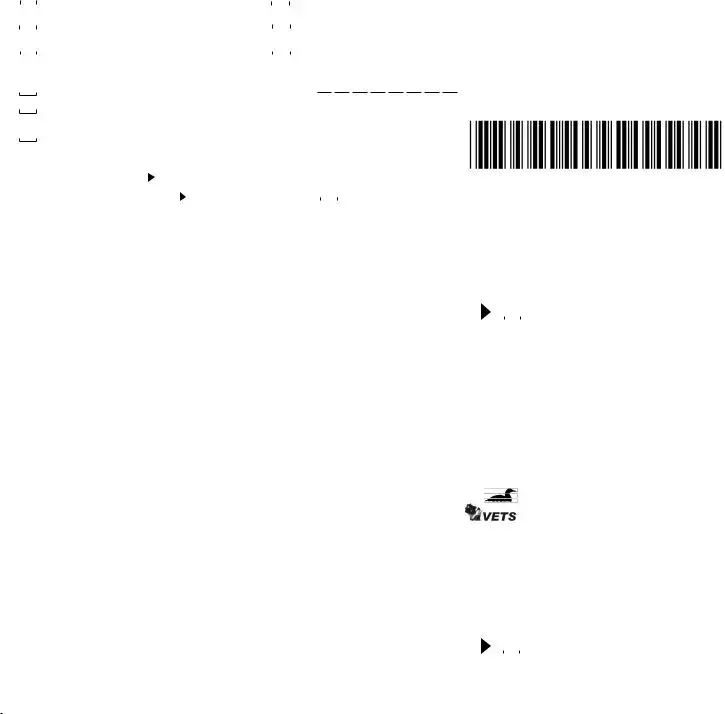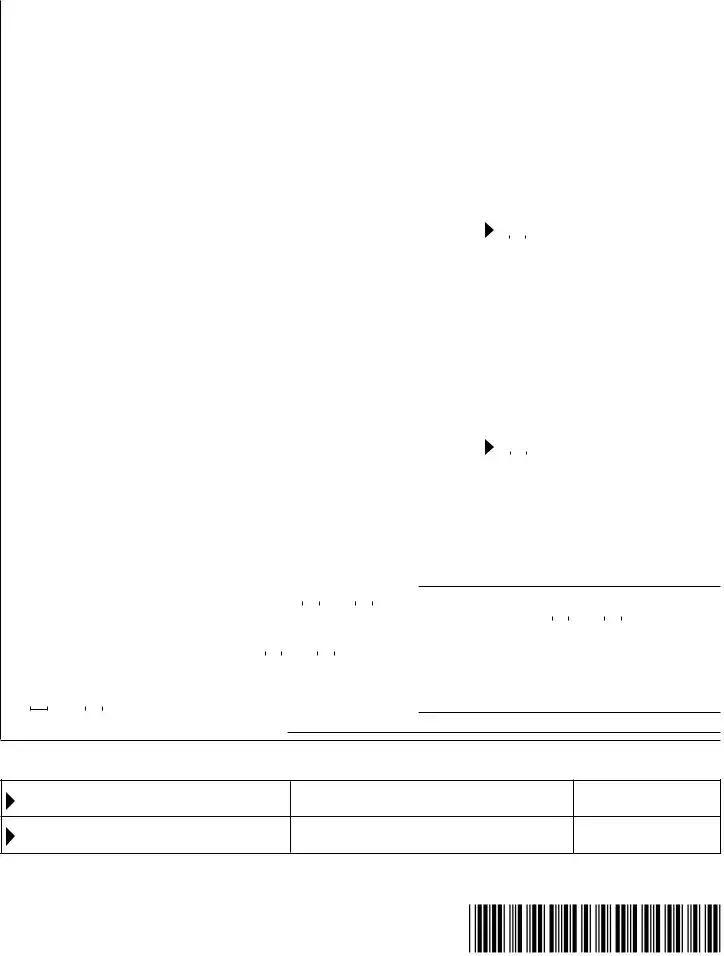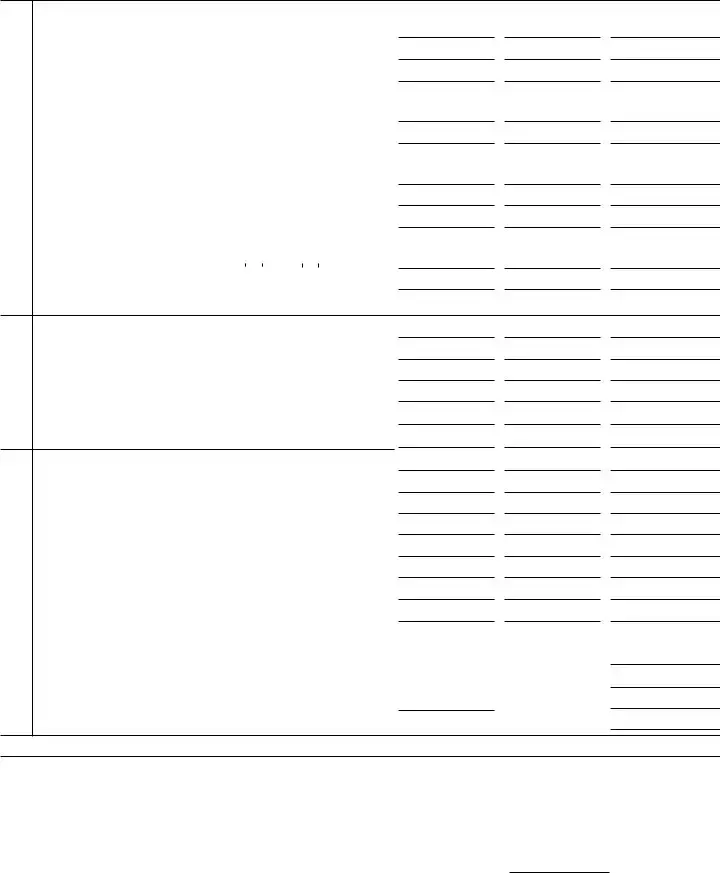|
|
(a) Pro rata share items |
|
|
(b) Federal amount |
(c) Adjustment |
|
(d) Amount under Wis. law |
1 |
Ordinary business income (loss) |
. |
|
|
|
|
|
|
2 |
. . . . .Net rental real estate income (loss) (attach Form 8825) |
. |
|
|
|
|
|
|
3 |
. . . . . . . . . . .Other net rental income (loss) (attach schedule) |
. |
|
|
|
|
|
|
4 |
. . . . . . . . . . . . . . . . . . . . . . . . . . . . . . . . . . . . .Interest income |
. |
|
|
|
|
|
|
5 |
. . . . . . . . . . . . . . . . . . . . . . . . . . . . . . . . . .Ordinary dividends |
. |
|
|
|
|
|
|
6 |
. . . . . . . . . . . . . . . . . . . . . . . . . . . . . . . . . . . . . . . . . .Royalties |
. |
|
|
|
|
|
|
7 |
. . . . . . . . . . . . . . . . . . . . . . .Net short-term capital gain (loss) |
. |
|
|
|
|
|
|
8 |
. . . . . . . . . . . . . . . . . . . . . . . .Net long-term capital gain (loss) |
. |
|
|
|
|
|
|
9 |
. . . . . . . . . . .Net section 1231 gain (loss) (attach Form 4797) |
. |
|
|
|
|
|
|
10 |
. . . . . . . . . . . . . . . . . . .Other income (loss) (attach schedule) |
. |
|
|
|
|
|
|
11 |
. . . . . . . . . . . . . . .Section 179 deduction (attach Form 4562) |
. |
|
|
|
|
|
|
12 |
a |
. . . . . . . . . . . . . . . .Contributions |
. |
|
|
|
|
|
|
|
b |
. . . . . . . . . . . . . . . .Investment interest expense |
. |
|
|
|
|
|
|
|
c |
Section 59(e)(2) expenditures (1) Type |
|
|
|
|
|
|
|
|
|
|
|
(2) Amount |
. |
|
|
|
|
|
|
|
d |
. . . . . . . . . . . . . . . .Other deductions (attach schedule) . . . |
. |
|
|
|
|
|
|
13 |
a |
Manufacturing investment credit - from carryover at shareholder level |
|
|
|
b |
. . . . . . . . . . . . . . . . . . . . . . . . . . . . .Manufacturing investment credit - from carryover at entity level |
|
|
c |
. . . . . . . . . . . . . .Dairy and livestock farm investment credit |
. . |
. . . . . . . . . . . . . . . . |
. . . . . . . . . . . . . . |
|
|
|
d |
. . .Health Insurance Risk-Sharing Plan assessments credit |
. . |
. . . . . . . . . . . . . . . . |
. . . . . . . . . . . . . . |
|
|
|
e |
. . . . . . . . . . . . . . . .Ethanol and biodiesel fuel pump credit. |
. . |
. . . . . . . . . . . . . . . . |
. . . . . . . . . . . . . . |
|
|
|
f |
. . . . . . . . . . . . . . . .Development zones credit |
. . |
. . . . . . . . . . . . . . . . |
. . . . . . . . . . . . . . |
|
|
|
g |
. . . . . . . . .Development opportunity zone investment credit |
. . |
. . . . . . . . . . . . . . . . |
. . . . . . . . . . . . . . |
|
|
|
h |
. . . . . . . . . . . .Development zone capital investment credit |
. . |
. . . . . . . . . . . . . . . . |
. . . . . . . . . . . . . . |
|
|
|
i |
. . . . . . . . . . . . . . . .Economic development tax credit |
. . |
. . . . . . . . . . . . . . . . |
. . . . . . . . . . . . . . |
|
|
|
j |
. . . . . . . . . . . . . . . .Technology zone credit |
. . |
. . . . . . . . . . . . . . . . |
. . . . . . . . . . . . . . |
|
|
|
k |
. . . . . . . . . . . . . . . .Early stage seed investment credit. . . . |
. . |
. . . . . . . . . . . . . . . . |
. . . . . . . . . . . . . . |
|
|
|
l |
. . . . .Supplement to federal historic rehabilitation tax credit |
. . |
. . . . . . . . . . . . . . . . |
. . . . . . . . . . . . . . |
|
|
|
. . . . . . . . . . . . . . . . . . . . . . . . . . .m Internet equipment credit |
. . |
. . . . . . . . . . . . . . . . |
. . . . . . . . . . . . . . |
|
|
|
n |
. . . . . . . . . . .Dairy manufacturing facility investment credit |
. . |
. . . . . . . . . . . . . . . . |
. . . . . . . . . . . . . . |
|
|
|
o |
. . . . . . . . . . . . . . . .Dairy cooperatives credit |
. . |
. . . . . . . . . . . . . . . . |
. . . . . . . . . . . . . . |
|
|
|
p |
. . . . . . . . . . . . . .Meat processing facility investment credit |
. . |
. . . . . . . . . . . . . . . . |
. . . . . . . . . . . . . . |
|
|
|
q |
. . . . . . . . . . . . . . . .Enterprise zone jobs credit |
. . |
. . . . . . . . . . . . . . . . |
. . . . . . . . . . . . . . |
|
|
|
r |
. . . . . . . . . . . . . . . .Film production services credit |
. . |
. . . . . . . . . . . . . . . . |
. . . . . . . . . . . . . . |
|
|
|
s |
. . . . . . . . . . . . .Film production company investment credit |
. . |
. . . . . . . . . . . . . . . . |
. . . . . . . . . . . . . . |
|
|
|
t |
. . . . . . . . . . . . . . . . . . . . . . . . . . . . . . .Food processing plant and food warehouse investment credit |
|
|
u |
. . . . . . . . . . . . . . . .Jobs tax credit |
. . |
. . . . . . . . . . . . . . . . |
. . . . . . . . . . . . . . |
|
|
|
v |
. . . . . . . . . . . . . . . .Postsecondary education credit |
. . |
. . . . . . . . . . . . . . . . |
. . . . . . . . . . . . . . |
|
|
|
w |
. . . . . . . .Woody biomass harvesting and processing credit |
. . |
. . . . . . . . . . . . . . . . |
. . . . . . . . . . . . . . |
|
|
|
x |
. . . . . . . . . . . . . . . .Water consumption credit |
. . |
. . . . . . . . . . . . . . . . |
. . . . . . . . . . . . . . |
|
|
|
yy Tax paid to other states (enter postal abbreviation of state) |
(1) |
|
|
. . . . . . . . . . . . . . |
|
|
|
|
|
|
|
|
|
|
|
|
(2) |
|
|
. . . . . . . . . . . . . . |
|
|
|
|
|
|
(3) |
|
|
. . . . . . . . . . . . . . |
|
|
|
zz Wisconsin tax withheld (do not include tax properly claimed on page 1, line 15) |
. . . . . . . . . . . . . . |
|
|
14 |
a |
. . . . . . . . . . . . . . . .Name of country or U.S. possession . . |
. |
|
|
|
|
|
|
|
b |
. . . . . . . . . . . . . . . .Gross income from all sources |
. |
|
|
|
|
|
|
|
c |
. . . . . . . . . . . . .Gross income sourced at shareholder level |
. |
|
|
|
|
|
|




